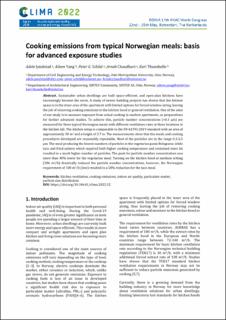| dc.contributor.author | Jutulstad, Adele | |
| dc.contributor.author | Yang, Aileen | |
| dc.contributor.author | Schild, Peter G. | |
| dc.contributor.author | Chaudhuri, Arnab | |
| dc.contributor.author | Thunshelle, Kari | |
| dc.date.accessioned | 2022-10-04T13:05:04Z | |
| dc.date.available | 2022-10-04T13:05:04Z | |
| dc.date.created | 2022-09-28T08:01:10Z | |
| dc.date.issued | 2022 | |
| dc.identifier.isbn | 978-94-6366-564-3 | |
| dc.identifier.uri | https://hdl.handle.net/11250/3023640 | |
| dc.description.abstract | Sustainable urban dwellings are built space-efficient, and open-plan kitchens have increasingly become the norm. A study of newer building projects has shown that the kitchen space is in the inner area of the apartment with limited options for forced window airing, leaving the job of removing cooking emissions to the kitchen hood or general ventilation. One of the aims of our study is to measure exposure from actual cooking in modern apartments, as preparations for further advanced studies. To achieve this, particle number concentrations (>0.3 μm) are measured for three typical Norwegian meals with different ventilation rates at three locations in the kitchen lab. The kitchen setup is comparable to the EN 61591:2019 standard with an area of approximately 30 m2 and a height of 2.7 m. The measurements show that the meals and cooking procedures developed are reasonably repeatable. Most of the particles are in the range 0.3-2.5 μm. The meal producing the lowest numbers of particles is the vegetarian pasta Bolognese, while taco and fried salmon which required both higher cooking temperature and contained more fat resulted in a much higher number of particles. The peak for particle number concentration was more than 40% lower for the vegetarian meal. Turning on the kitchen hood at medium setting (286 m3/h) drastically reduced the particle number concentrations, however, the Norwegian requirement of 108 m3/h (low) resulted in a 58% reduction for the taco meal. | en_US |
| dc.language.iso | eng | en_US |
| dc.publisher | TU Delft Open | en_US |
| dc.relation.ispartof | Proceeding of the The 14th REHVA HVAC World Congress 22nd-25th May, Rotterdam, The Netherlands | |
| dc.relation.ispartof | The 14th REHVA HVAC World Congress. Clima 2022 | |
| dc.relation.uri | dx.doi.org/10.34641/clima.2022.52 | |
| dc.rights | CC BY 4.0 | * |
| dc.rights.uri | http://creativecommons.org/licenses/by/4.0/ | * |
| dc.subject | Kitchen ventilation | en_US |
| dc.subject | Cooking emissions | en_US |
| dc.subject | Indoor air quality | en_US |
| dc.subject | Particulate matter | en_US |
| dc.subject | Particle size distribution | en_US |
| dc.title | Cooking emissions from typical Norwegian meals: basis for advanced exposure studies | en_US |
| dc.title.alternative | Cooking emissions from typical Norwegian meals: basis for advanced exposure studies | en_US |
| dc.type | Chapter | en_US |
| dc.type | Peer reviewed | en_US |
| dc.description.version | publishedVersion | en_US |
| dc.rights.holder | © 2022 The authors | en_US |
| dc.subject.nsi | VDP::Teknologi: 500 | en_US |
| dc.identifier.doi | 10.34641/clima.2022.52 | |
| dc.identifier.cristin | 2056122 | |
| dc.relation.project | Norges forskningsråd: 308819 | en_US |
| cristin.ispublished | true | |
| cristin.fulltext | original | |

